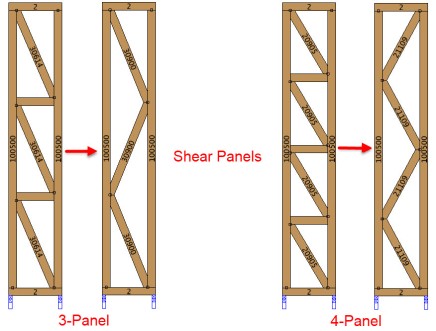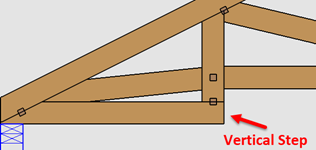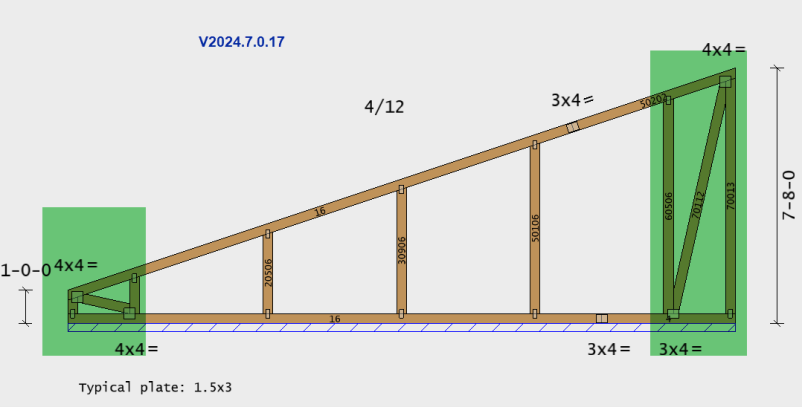Field Descriptions
| Setting | Description |
|
Min interior separation between TC and BC for truss to be valid |
Maximum gap between the TC and BC to define a valid truss. Minimum is 0; maximum is 1-00-00. |
|
Minimum distance between inside edges of chords (lower edge of TC to upper edge of BC) to be valid; there must be room for webs to fit. |
|
|
Set a limit to move a panel point when forcing a vertical web. Minimum is 0; maximum is 2-00-00. |
|
|
Maximum distance between two panel points in order to merge them. Minimum is 0; maximum is 2-00-00. |
|
|
Limit on the minimum length of a legitimate chord. Minimum is 02-00; maximum is 10-00. |
|
|
Bearing height at the right end of the truss. Minimum is -20-00-00, Maximum is 84-00-00, where 84floats the bearing to the bottom chord. |
|
|
Creates box joint at a pitch break when the pitch difference is between Minimum 1.0; maximum 2.0. |
|
|
Maximum allowed length of a scarf cut. Minimum is 01-00; maximum is 2-00-00. |
|
|
Prevents web end cuts that are less than the specified angle |
|
|
Maximum distance at heel joints between the inside edges of the chords, for which a web can be used to fill the gap |
|
|
True cuts the webs in a joint perpendicular to the chord; false leaves them vertical. |
|
|
True forces all webs to be single cut; false allows multiple cuts. |
|
|
Select between 0.01 and 1.00 square inches. This option allows areas of member overlap that are that size or smaller to be ignored during analysis, allowing the truss to run without a failure due to overlap error cut. Default is 0.1 square inches. |
|
|
True creates Howe webbing pattern |
|
|
True places a vertical under the sloped member at Hip; false places it under the flat member. |
|
|
Choose from None, Both, TC, or BC. When using vertical webs at pitch breaks, Truss Studio automatically adds additional vertical and diagonal webs when this setting is enabled. |
|
|
When set to True and a vertical web is placed at the end of a bearing location, the vertical web width matches the size of the end bearing |
|
|
True allows vertical webs to be placed at interior bearings |
|
|
Vertical webs at interior bearings match bearing size up to this size |
True force verticals at interior bearings, and allows the size of the web to correspond to the bearing size. |
|
True double cuts the flat chord at California hip; false single cuts. |
|
|
True keeps vertical webs at California Hip Shoulder locations the same for trusses with 2x6, 2x8, 2x10, and 2x12 flat chords as those with 2x4 flat chords |
|
|
True generates a web seat cut on a BC scissors joint; false does not. |
|
|
True generates same length diagonal webs in flat sections; false does not. |
|
| Hold end diagonal back from end for open Jacks |
True holds the diagonal web back from the end of the bottom chord. For the distance of the hold back,set the dimension in the End vertical hold back setting (see below). false does not hold the diagonal back; it ends at the end of the bottom chord. |
| Skip splices when dividing chord segments into panels | True skips splices when dividing chord segments; false does not. |
| End vertical hold back | Holds back a vertical web the specified distance |
| End type control; larger depths require end vert in place of slider | Controls whether a slider is used in raised heel conditions |
| End Type control; min scarf contact with brg | Horizontal length of connection between top chord and bottom chord; used to determine point at which reinforcement between them is added when there is a bearing at the heel. |
| End Type control; min scarf contact no brg | Horizontal length of connection between top chord and bottom chord; used to determine point at which reinforcement between them is added when there is not a bearing at the heel. |
| Distance to auto-extend scab beyond joint | Default distance to automatically extend a scab beyond a joint |
| Shear Panel vertical panel length | Default length of a vertical in a shear panel |
| Divide Shear Panel into equal sections |
True automatically divides shear panels into equal sections.
|
| Shear Panel Horizontal Webs |
Create shear panel with or without horizontal webs. This may provide a more economical design and use less lumber.
|
| Attic - factor of span allowed for room width | Define the upper limit allowed for attic room width |
| Attic - (inches) search range for joints that can be moved |
When placing a sidewall, Truss Studio searches for adjacent joints. If a moveable joint is found to be “close enough” the joint is moved to become the sidewall joint. |
| Attic - (inches) offset allowed for including a sidewall in attic | Determines when a joint (often a break joint) is close enough to allow the sidewall to become part of the joint |
| Attic - (inches) TB web length and short panels minimum | Used in webbing over the tie beam |
| Attic - (inches) joints too close for webbing | Define which joints are too close for webbing |
| Attic - (inches) clear spaces adjacent to sidewalls before re-connect | Define the space adjacent to sidewalls |
| Gambrel Attic - TieBeam cutting at break joint |
Specify where to cut the tie beam for gambrel-shaped attic truss. Options include:
See Create Gambrel Attic. |
| Trimmed let-in falling within the dist of a web or filler member will be auto-extended to abut. |
When let-in member is within the specified distance of another web, it will be auto-trimmed to cut against that other web. |
| OFF - Set chord splice away from web interface by |
Specify the distance in inches, with a range of 0 to 6', with a default of 2.5". |
| Angle from chord to auto single-cut (-1 to disable) |
Specify the angle in degrees. |
| BC holdback for ribbon at tray or coffer ceiling |
Select an amount to define default bottom chord holdback at vertical step locations without trimming.
|
| Single-cut BC end of single-cut TC web |
Select True or False. When set to True, any web that is single-cut against the TC will also have the BC end of the same member single-cut against the BC. |
| Show mid-to-panel-length dimensions along the chord |
When set to True, dimension lines based on the entered "along slope" panel entries will be automatically created and made available for jig output reports. Not currently implemented. |
| Show TC overhang dimensions along the chord |
When set to True, dimension lines based on the entered "along slope" panel entries will be automatically created and made available for jig output reports. Not currently implemented. |
| Mark webs connected to break joints as gable stud |
When set to True, webs connected to break joints are marked as gable studs. Each web has a “Is Gable Stud” property in Truss Studio that is used to communicate to Director whether that web is to be labeled as a gable stud or not. Many times, you can create a regular truss with pitch breaks where the “original” profile already has verticals at the pitch break locations, for example:
This setting is related to batching. Each web has a “Is Gable Stud” property that is used to communicate to Director whether that web should be labeled as a gable stud. When a truss is gabled, and this preset is set to False, the property of the vertical web at the pitch break joint is “No” for the “Is Gable Stud” (it is considered a regular web, not a gable stud).
If the preset is True, it automatically creates the gable stud with the “Is Gable Stud” property as “Yes.”
Note that this setting does not impact the design of the truss in Truss Studio. It is used to mark how this member is treated in Director. |
| Add diagonals on raised heelp gables |
When True, and you create a raised-heel gable resulting in end verticals (stub-end condition) at both ends of the truss without checking the Structural Gable or Lay-in Gable options in the Gable dialog; structural end diagonals are added as part of the end condition. This helps with racking stability. The default for this setting is False.
|
| Special-cut ends of Wx2 odd diagonals | Select None, Single-Cut, or Square-Cut for odd length webs. |
| ...Apply to webs shorter than | Enter the web length. Webs shorter than this number will be special cut. |
| Min chord step for K-Web webbing | Enter the minimum chord step |
| Mark horizontal girts as gable studs | When set to True, selected horizontal girts are marked as gable studs and display as such in Properties pane. False leaves these members as webs. This setting impacts how these are batched/grouped in Director. |
| Add | Enter the minimum chord step |






